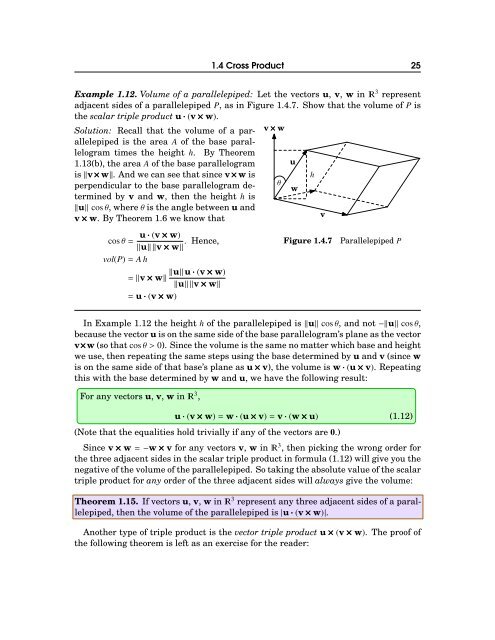Michael Corral: Vector Calculus
Michael Corral: Vector Calculus
Michael Corral: Vector Calculus
You also want an ePaper? Increase the reach of your titles
YUMPU automatically turns print PDFs into web optimized ePapers that Google loves.
1.4 Cross Product 25<br />
Example 1.12. Volume of a parallelepiped: Let the vectors u, v, w in 3 represent<br />
adjacent sides of a parallelepiped P, as in Figure 1.4.7. Show that the volume of P is<br />
the scalar triple product u·(v×w).<br />
Solution: Recall that the volume of a parallelepiped<br />
is the area A of the base parallelogram<br />
times the height h. By Theorem<br />
1.13(b), the area A of the base parallelogram<br />
is‖v×w‖. And we can see that since v×w is<br />
perpendicular to the base parallelogram determined<br />
by v and w, then the height h is<br />
‖u‖ cosθ, whereθistheanglebetweenuand<br />
v×w. By Theorem 1.6 we know that<br />
cosθ= u·(v×w)<br />
‖u‖‖v×w‖ . Hence,<br />
vol(P)=Ah<br />
=‖v×w‖ ‖u‖u·(v×w)<br />
‖u‖‖v×w‖<br />
= u·(v×w)<br />
v×w<br />
θ<br />
u<br />
w<br />
h<br />
v<br />
Figure 1.4.7 Parallelepiped P<br />
In Example 1.12 the height h of the parallelepiped is‖u‖ cosθ, and not−‖u‖ cosθ,<br />
becausethevectoruisonthesamesideofthebaseparallelogram’splaneasthevector<br />
v×w(sothatcosθ>0). Sincethevolumeisthesamenomatterwhichbaseandheight<br />
we use, then repeating the same steps using the base determined by u and v (since w<br />
is on the same side of that base’s plane as u×v), the volume is w·(u×v). Repeating<br />
this with the base determined by w and u, we have the following result:<br />
For any vectors u, v, w in 3 ,<br />
u·(v×w)=w·(u×v)=v·(w×u) (1.12)<br />
(Note that the equalities hold trivially if any of the vectors are 0.)<br />
Since v×w=−w×v for any vectors v, w in 3 , then picking the wrong order for<br />
the three adjacent sides in the scalar triple product in formula (1.12) will give you the<br />
negativeofthevolumeoftheparallelepiped. Sotakingtheabsolutevalueofthescalar<br />
triple product for any order of the three adjacent sides will always give the volume:<br />
Theorem 1.15. If vectors u, v, w in 3 represent any three adjacent sides of a parallelepiped,<br />
then the volume of the parallelepiped is|u·(v×w)|.<br />
Another type of triple product is the vector triple product u×(v×w). The proof of<br />
the following theorem is left as an exercise for the reader:








